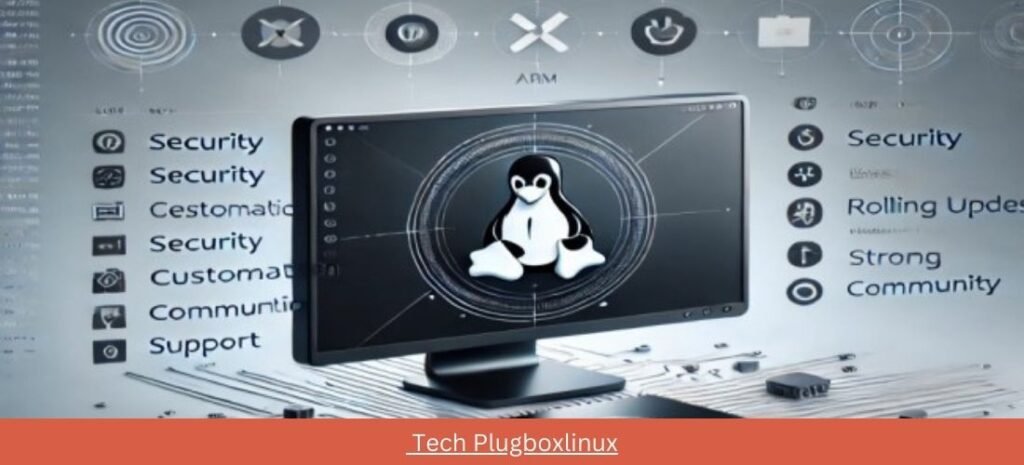What is Plug Box Linux?
Plug Box Linux is an emerging Tech Plugboxlinux distribution designed for users who want a flexible, secure, and highly customizable operating system. It caters to individuals who seek more control over their system environment, whether for personal use, professional development, or systems administration. This OS stands out for its blend of user accessibility and robust features, providing an exceptional foundation for both new and experienced Linux users. Here, we will explore the core elements, unique attributes, and benefits of Tech Plugboxlinux to give you a complete understanding of its potential.
Key Features of Tech Plugboxlinux

1. User-Friendly Interface
Plug Box Linux emphasizes a user-friendly interface tailored to improve accessibility for both beginners and advanced users. The OS offers a clean, intuitive design that is easy to navigate, yet rich in features. This accessibility enables users to perform essential functions, configure settings, and manage applications without requiring extensive Tech Plugboxlinux experience. Additionally, the OS includes a variety of desktop environments, allowing users to choose the look and feel that best suits their preferences and workflow needs.
2. Comprehensive Software Repository
Tech Plugboxlinux boasts a comprehensive software repository that includes a wide range of applications and utilities, ensuring users have immediate access to the tools they need. The repository is regularly updated with new and secure packages, spanning categories such as productivity, multimedia, and development. This extensive catalog simplifies the installation process, as users can access both common and specialized software directly from the Plug Box Linux package manager, enhancing convenience and time efficiency.
3. Robust Security Measures
Security is paramount in Plug Box Tech Plugboxlinux. It incorporates robust security measures designed to protect users against potential threats. Built with features such as frequent security patches, data encryption options, and firewall configurations, Plug Box Linux provides a fortified environment. These proactive security controls ensure that data remains protected, while the OS’s open-source nature allows the community to inspect, identify, and address vulnerabilities quickly.
4. Performance and Stability
Optimized for performance and stability, Plug Box Tech Plugboxlinux utilizes lightweight software packages and efficient resource management techniques, making it suitable for both high-performance systems and older hardware. The OS ensures that applications run smoothly, reducing lag and minimizing crashes. This consistency is vital for users who rely on their systems for critical tasks, as Plug Box Linux is crafted to deliver a reliable experience, whether the device is used for personal tasks, work, or even gaming.
5. Customizability
One of the standout features of Plug Box Tech Plugboxlinux is its customizability. Users can configure and personalize nearly every aspect of the OS, from desktop themes to system utilities. This flexibility makes it easy for users to tailor their environments based on their preferences and specific needs. Customizability also extends to system performance and resource management, allowing users to optimize their setups for speed or efficiency based on their usage requirements.
Installation Guide for Tech Plugboxlinux
Setting up Plug Box Tech Plugboxlinux is straightforward and follows a step-by-step process. Below is a detailed guide to assist you in the installation process.
1. Download the ISO File
The first step is to download the ISO file for Plug Box Tech Plugboxlinux from the official website. The ISO file is the disk image that will be used to install the OS onto your computer. Ensure you download the latest version to take advantage of the most recent updates and features.
2. Create a Bootable USB Drive
Once the ISO file is downloaded, create a bootable USB drive. This USB drive will allow your computer to boot directly into the Tech Plugboxlinux installer. Tools like Rufus (for Windows) or Etcher (for macOS and Linux) are recommended for this step. Simply select the Plug Box Linux ISO file and the USB drive you wish to use, and follow the prompts provided by the tool.
3. Boot from USB
Insert the bootable USB drive into your computer and restart the system. Access the boot menu by pressing the appropriate key (often F2, F12, or ESC, depending on the system), then select the USB drive as the boot device. This action will load the Plug Box Tech Plugboxlinux installer.
4. Install Plug Box Linux
Follow the on-screen instructions to install Tech Plugboxlinux. The installation wizard will guide you through options like partitioning, selecting the installation location, and configuring basic system settings. For new users, opting for the default settings is recommended, while advanced users can customize the partitioning and other configurations as needed.
5. Post-Installation Setup
After the installation is complete, remove the USB drive and restart your system. Plug Box Linux should now boot up, allowing you to complete the post-installation setup. This step includes updating system packages, setting up user accounts, and installing additional software. It’s also advisable to check for any available updates to ensure your system is fully equipped with the latest security patches and features.
Read Also : Tarang Water Park in Ranchi, Jharkhand |Tarang Water Park distance
Advantages and Disadvantages of Tech Plugboxlinux
Advantages
- Lightweight and Efficient
Tech Plugboxlinux is designed with a minimalist approach, offering only essential components and omitting unnecessary software. This results in faster boot times, reduced memory usage, and efficient performance, especially on devices with limited resources. - Rolling Release Model
The rolling release model keeps the system continuously updated with the latest features, security patches, and software releases without requiring a complete reinstallation. This ensures that users always have access to the newest improvements and fixes. - Optimized for ARM Architecture
PlugboxLinux’s optimization for ARM architecture makes it ideal for low-power devices, such as plug computers and IoT systems. It allows users to create high-performance environments on ARM-based devices, enhancing their versatility and functionality. - Customizable and Flexible
Users have significant control over system configurations, from the kernel settings to software packages and desktop environments. This high degree of customization allows users to tailor Tech Plugboxlinux to specific use cases, creating a personalized operating system. - Pacman Package Manager
Tech Plugboxlinux uses the Pacman package manager, known for its speed and simplicity. Pacman’s robust repository includes core packages and access to the Arch User Repository (AUR), enabling users to install and manage an extensive range of software options. - Strong Community Support
The Arch and PlugboxLinux communities offer substantial support through forums, wikis, and documentation. This active user base provides troubleshooting assistance, guides, and best practices, which are invaluable for both beginners and experienced users.
Disadvantages
- Steep Learning Curve
PlugboxLinux’s minimalist design and emphasis on customization can be challenging for beginners or users unfamiliar with Linux. Configuring and managing the system often requires advanced knowledge of Linux commands and system management. - Potential Stability Issues
While the rolling release model keeps software updated, it can occasionally introduce bugs or compatibility issues, as new updates may not be thoroughly tested before release. This can result in system instability, requiring users to troubleshoot or roll back updates. - Limited Out-of-the-Box Functionality
Unlike other Linux distributions, PlugboxLinux provides a basic installation with minimal applications. Users must manually install many common software packages, which may be time-consuming and complex for those new to Linux. - Compatibility Constraints
PlugboxLinux is optimized for ARM architecture, so it is not compatible with x86 systems or all ARM-based hardware. Users must ensure their hardware is compatible, and even then, some devices may require additional setup steps to function correctly. - Security Responsibility
While PlugboxLinux includes security patches through updates, its minimal and customizable design places the responsibility for securing the system on the user. Advanced configurations, firewalls, and security tools often need to be set up manually. - Requires Regular Maintenance
The rolling release model demands that users regularly update their system to maintain stability and security. Users who do not stay updated might face incompatibility issues, particularly with the latest packages or system dependencies.
Read Also : Snapdeal Seller Login: A Comprehensive Guide
Benefits of Using Plug Box Linux
1. Cost-Effective
Plug Box Linux is an open-source and free operating system, making it highly cost-effective. Users do not need to pay for licenses or subscriptions, as they would with some proprietary operating systems. This financial benefit, combined with its robust capabilities, makes Plug Box Linux an attractive option for individuals, educational institutions, and businesses alike.
2. Community Support
As with many Linux distributions, Plug Box Linux has a strong community of users and developers who contribute to its development and maintenance. This community-driven approach means users have access to forums, guides, and troubleshooting resources. It also fosters collaborative improvement, as community members are constantly working to enhance features, security, and overall user experience.
3. Regular Updates
The development team behind Plug Box Linux is committed to providing regular updates, ensuring that users benefit from the latest advancements in technology, security, and usability. These updates address any emerging issues, enhance functionality, and integrate user feedback, making Plug Box Linux a continuously evolving OS that aligns with modern requirements.
4. Flexibility
Plug Box Linux offers extensive flexibility in terms of system configuration and application choices. Users have the freedom to install software from multiple sources, configure system settings to their liking, and even modify the kernel if they have advanced knowledge. This flexibility enables users to create an OS environment that matches their specific needs, whether for everyday tasks or specialized projects.
Conclusion
Plug Box Linux presents itself as a highly capable and flexible operating system, ideal for users seeking a blend of customizability, stability, and security. Its user-friendly interface, comprehensive software repository, and robust security make it an appealing choice for a diverse range of users. With clear installation steps, extensive community support, and regular updates, Plug Box Linux stands as a reliable option within the Linux ecosystem. By choosing Plug Box Linux, users benefit from an OS that prioritizes user experience, performance, and cost-effectiveness.



